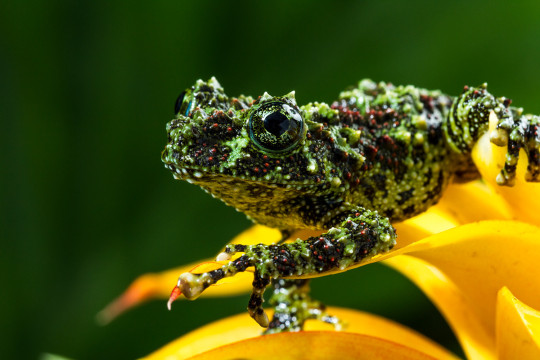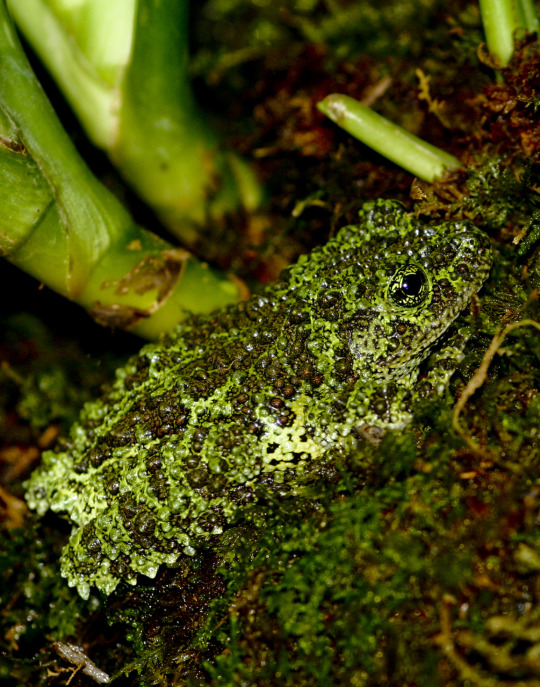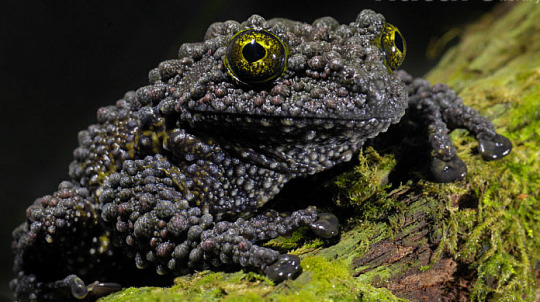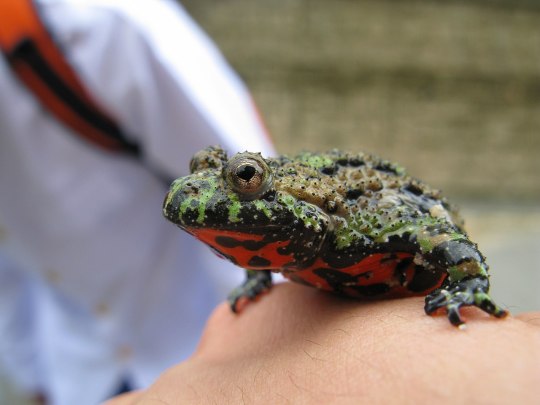#theloderma
Explore tagged Tumblr posts
Text

Vietnamese Mossy Frog (Theloderma corticale), family Rhacophoridae, found in northern Vietnam, south–central Laos, and southern China
photograph by Loi Phuoc Tran
1K notes
·
View notes
Text

Vietnamese Mossy Frog (Theloderma corticale)
Photo by Michael D Kern
#Theloderma corticale#Theloderma#vietnamese mossy frog#mossy frog#frog#green#green frogs#moss#amphibians#animals#wildlife#nature
123 notes
·
View notes
Text
Theloderma corticale, a magnificent camouflage artist.

2K notes
·
View notes
Text
Vietnamese mossy frog - Theloderma corticale
Little tip : take a look at the Smithsonian's National Zoo's website, they have pictures of Vietnamese mossy frogs on there that are so freaking cute ! They look like proper little models, it is so adorable !
@hispaatra spam-tagging you a bit, but this might interest you :D


Description
The common name "mossy frog" arises from the fact that it greatly resembles a clump of moss thanks to their green color, black spots, and visible tubercules and spines. Their exterior resembles moss growing on rock, and forms an effective form of camouflage. They hide in basins of water found in crevices with only their eyes protruding to keep a watchful eye on their surroundings. As a result, they're almost impossible to spot when fixed.
They have large soft underbelly and adhesive toe pads, and can jump. Males have a pronounced breeding callus on the base of their inside finger. They measure about 61 millimetres. The females will grow larger than the males and can reach sizes of 8 to 9 centimetres, while the males tend to be smaller and thinner. This species will curl into a ball when frightened, and play dead.
Behaviour - diet, sleep habits, communication
Diet - Mossy frogs hunt large insects such as crickets and cockroaches. But they are also known to feed on earthworms.
Sleep habits - Vietnamese mossy frogs are active at night, and presumably passive during most of the day time.
Communication - Vietnamese mossy frogs can throw their voices up to 3 to 4 meters, making it extremely difficult to find them in the wild. To explain this further, because of the large range, it is hard to pin-point the exact source of the sound.
Reproduction
Vietnamese mossy frogs breed in rock cavities where water has flooded the floor. A clutch of eight to ten eggs is deposited above the water to protect them from aquatic predators. These eggs hatch in seven to fourteen days and the newly hatched tadpoles drop into the water directly below them. Metamorphosis from tadpole to frog takes about three months.
Distribution and habitat
As its name suggests, the Vietnamese mossy frog lives in Vietnam, specifically in northern Vietnam, a region defined by limestone cliffs and evergreen rainforests. It is also known to be found in south-central Laos, and southern China (Guangdong, Guangxi, Hainan, Yunnan).
Its natural habitats are primarily evergreen rainforests and subtropical forest where they are found in flooded caves and in the banks of rocky mountain streams at elevations of 700 to 1,000 meters. This semi-aquatic species spends much of the time hiding in the water under rocks and floating plants. They will also attach themselves to rock crevices, appearing to be moss.
Conservation
Its habitat is threatened by forest loss. It is also collected for the international pet trade. Like many amphibians, the Vietnamese mossy frog is vulnerable to the chytrid fungus Batrachochytrium dendrobatidis. Nonetheless, the conservation of this species is classified as "Least Concern" by the International Union for Conservation of Nature.
~~~~~~~~~~~~~~~~~~~~~~~~~~~~~~~~~~~~~~~~~
Image sources:
1.
https://www.bigappleherp.com/products/vietnamese-mossy-tree-frogs
2.
https://www.australiangeographic.com.au/blogs/creatura-blog/2020/05/the-mossy-frog-is-the-sweetest-thing/
~~~~~~~~~~~~~~~~~~~~~~~~~~~~~~~~~~~~~~~~~
Text references:
1.
https://en.wikipedia.org/wiki/Theloderma_corticale
2.
https://nationalzoo.si.edu/animals/vietnamese-mossy-frog
106 notes
·
View notes
Text

A Khoi's mossy frog (Theloderma khoii).
Image © Nguyen Thien TAO.
24 notes
·
View notes
Note
Egg! I love Animal

Tonkin bug-eyed frog!
(Theloderma corticale)
32 notes
·
View notes
Text
Over recent years the Vietnamese mossy frog, Theloderma corticale, has become commonplace in zoo reptile houses, and much more common in the exotic pet trade. This is a frog with good sexual size dimorphism, and the females, being the larger sex, can reach 9 centimeters or 3 and a 1/2 inches in snout to rump length, whilst the males are about an inch smaller by this same measurement. Vietnamese mossy frogs are members of the faunal community present in South Chinese provinces, and the northern, cooler areas of Laos and Vietnam.
Zoologically the frogs of the genus Theloderma nest among the important rhacophorid clade, that is named for the captivating flying frogs of genus Rhacophorus. The stunning Mantella frogs of Madagascar, also have a rhacophorid identity, or if they are not they remain closely allied to them. Rhacophorid frogs in fact nest among frogs with a history of being assigned to the ranid grouping, per their pre-cladistic definition.
Although rhacophorids are often characterised as arboreal frogs, a number of rhacophorid species, including members of the genus Theloderma, are much better categorized as non-arboreal anurans. Although rhacophorids might be called Asian tree frogs, no one believes they are related to the 'true' or hylid tree frogs, some of which are also not arboreal.
Vietnamese mossy frogs actually live close to the ground, in submontane primary forests in association with rocks and hollowed logs. They are always found around water, and they require humid air. When resting they collapse dorsoventrally, and their camouflage as moss is highly effective, making them very difficult to spot.
The regions where T. corticale is native have a seasonal climate, with monthly variations of average temperature, and of precipitation under the influence of the monsoon regime. Although submontane, subtropical environments are not as hot year round as those in the tropical lowlands, the air temperature may be warm in the summer. Koln Zoo has been breeding this species with a daytime air temperature, of 26 to 29 degrees centigrade. and an air humidity of 55 to 90%.
The water temperature was reported as 24 to 28 degrees, and the pH was 8. It might be relevant that wild T. corticale inhabit karst forest, where the geology happens to be limestone. These are not arboreal frogs, and they do not swim actively for long periods of time. Therefore although they are suited to an aquaterrarium, they do not need a large expanse of water. The footprint of the vivarium is at least as important than it's height, although it should be tall enough to allow them some natural clambering behavior.
Theloderma sp. are not very active frogs in any case, so they do not need a very large living space relative to their body sizes. The terrarium decor should include rocks, and also feature wood, because they are found in association with roots and hollow logs. If they can access water, as they should be able to, they must easily be able to get out again. Thus there should easily be shallows in the aquarium.
T. corticale are often housed with other animals in zoo exhibits. As a species they are inoffensive to other animals that they will not see as prey, and they easily cohabit with appropriately sized, peaceful species that use different areas of the same exhibit. T. corticale have been known to eat very small fish, so they should not be housed with animals they might be able to gulp down. For reference they usually eat items no longer, than the distance between their eyes.
0 notes
Text
Creature Awaits #235
Each week I plan to feature an amazing creature, admiring God's fantastic artistry. Hopefully it’ll brighten someone’s day to see something new and interesting if they haven’t seen it before. : )
Due to personal and work-related issues, I missed posting last week, so we're getting a double-post this week to make up for it. Apologies for the delay again! Hopefully things will be better again soon. : )
First, our final November camouflaged creature feature… : )

(Beautifully photographed by the talented, Brian Gratwicke (CC BY-NC 2.0 Deed))
The Vietnamese Mossy Frog
Scientific Name: Theloderma corticale
Region: Northern Vietnam through southern Laos and China
Size: About 2.4" (~6.1cm) long
Interesting Notes: This beautiful little frog's bumpy skin and mottled markings help it seamlessly blend into mossy forest floors and lichenous rock facings alike.
#creatureawaits#camouflage#interesting animals#cute animals#frogs#Vietnamese mossy frog#Theloderma corticale
0 notes
Note
i am the syscourse frog. would you like to guess what species i am? the blogger who gets it right gets bragging rights.
Are you, perhaps, this delightful Vietnamese Mossy Frog? (Theloderma corticale)

6 notes
·
View notes
Text
18th of October 2024: Brick-red Bug-eyed Frog

Another Friday has rolled around for us to appreciate another frog: the Brick-red Bug-eyed Frog (Theloderma lateriticum) [1]. They’re only around 2.5 cm in length and can be told apart from other frogs by the lack of webbing between their toes and their brick-red colour [2].
They were originally described in 2009, based upon a single guy found in Vietnam [2]. There was speculation for a while that their habitat extended to Southern China as well [3], which was indeed confirmed a decade later, where they also had the opportunity to record a male calling and to discover and describe their tadpoles [4].
Both times the frogs were found in rather interesting circumstances. The first he was found in a water-filled bamboo chamber near a cardamom farm. Inside the bamboo also were other frogs and a snake [2]. The Chinese Brick-red Bug-eyed Frog was found breeding in a PVC bucket [4]. So while obviously they are okay with some amount of human influence in their habitat, how much they can tolerate is not certain. It is suspected that the lack of records of them is due to them being hard to find rather than them being rare [3].
They likely reproduce by laying a few large eggs on leaves which can then slide off into small pools of water [3]. They also have several small keratinised bumps on their thighs [2].
Sources: [1] [2] [3] [4] [Image]
#critter of the day#critteroftheday#frog friday#frog#frog species#frog facts#animal facts#zoology#animal species#animal#herpetology
2 notes
·
View notes
Text

Vietnamese Mossy Frog (Theloderma corticale), family Rhacophoridae, northern Vietnam
photograph by Nova Inventa
554 notes
·
View notes
Text

Vietnamese Mossy Frog (Theloderma corticale), Vietnam
Photo by Michael D Kern
#mossy frog#vietnamese mossy frog#frog#theloderma#theloderma corticale#amphibians#tropical frogs#black#black frog#gray frog#animals#wildlife#nature#tropical
130 notes
·
View notes
Text

Vietnamese Mossy Frog (Theloderma cortical): Measuring at 9cm (3.5in),
David Kidoki photograph.
881 notes
·
View notes
Text
Vietnamese mossy frog - Theloderma corticale
Look at this gorgeous little fella ! It simultaniously looks like a little moss-covered goblin and a gemstone, I love it so much !


I'm not going to lie, the way that frog stares, is nearly the exact same way my cat looks 99% of the time. It's so cute !
~~~~~~~~~~~~~~~~~~~~~~~~~~~~~~~~~~~~~~~~~
Image sources:
1.
https://www.bigappleherp.com/products/vietnamese-mossy-tree-frogs
2.
https://www.australiangeographic.com.au/blogs/creatura-blog/2020/05/the-mossy-frog-is-the-sweetest-thing/
#hyperfixation#biology#herpetology#frogs#Vietnamese mossy frog#Theloderma corticale#I love this guy#<3
67 notes
·
View notes
Text


Oriental Fire-Bellied Toad: Found in Korea, and Northeastern Russia and China, these frogs are very intelligent and have found their way through mazes with water as a reward at the end. They lack eardrums and vocal sacs – calling on the inhale instead of the exhale. When threatened, they will arch their head and limbs and then flip onto their back, exposing their brightly coloured stomachs to indicate that they are poisonous. Those toxins are accrued from the insects they eat and secreted in a milky substance from near their legs.
Vietnamese Mossy Frog: This frog’s main defense is camouflage; if it fails, they curl up into a ball and play dead. They hide in caves and in mountain streams carved into the limestone cliffs of Northern Vietnam, either in the water or in crevices in the walls. When breeding, males can project their calls up to 4 metres (13 feet) away, making them difficult to locate by sound. They lay 8-10 eggs in pairs hanging above a pool of water which tadpoles drop into as they hatch 1-2 weeks later.
10 notes
·
View notes
Text

Vietnamese Mossy Frog (Theloderma corticale), family Rhacophoridae
1 note
·
View note